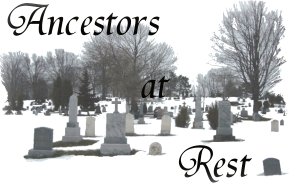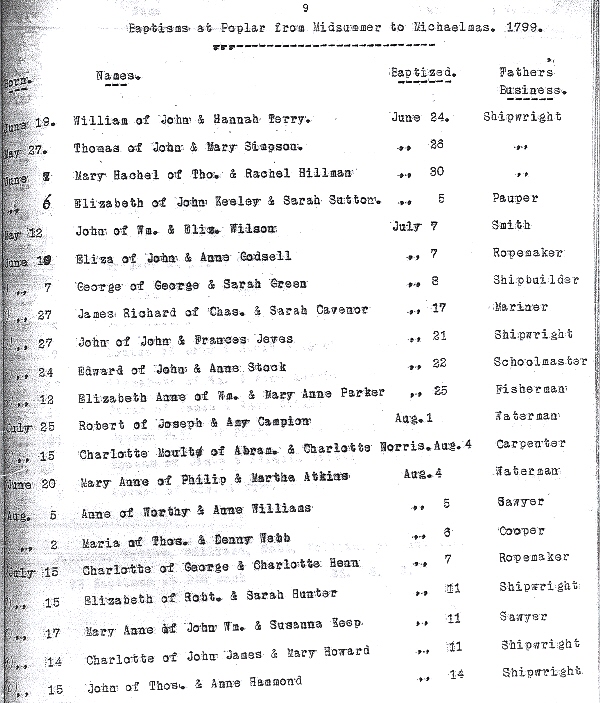|
JOIN the FREE Olive Tree Genealogy Newsletter.
Be the first to know of genealogy events and freebies. Find out when
new genealogy databases are put online. Get tips for finding your
elusive brick-wall ancestor.
|
Free Death Records By Location | | Search FREE Death Records by Country (USA, Canada, UK ...)
|
|
Genetic Genealogy | | Use DNA to find your Ancestors
|
|
Blogs |
Ancestors at Rest Death records of all kinds - funeral cards, death notices, cemetery receipts, obits...and more
Olive Tree Genealogy Updates on new genealogy Records online
Past Voices Letters from 1800s - from Civil War soldiers, from wives to husbands, sons to mothers, sisters to sisters.
|
|
Free Genealogy Stuff
| | Free genealogy stuff on the net
|
|
German Death Cards | | Find Your German Ancestors Death Card
|
|
|
Free Genealogy Records, Births And Baptisms In Poplar Chapel, London County, England 1584 ~ 1799
The peninsula called the Isle of Dogs was originally known as Stepney Marsh. Some of the marsh was drained in the 13th Century, and in the latter 14th Century a chapel was built to serve the spiritual needs of the small agricultural community which had grown in the area. This was destroyed in 1448 when the embankment keeping out the river failed and the land was again flooded.
The earliest reference to the area as the Isle of Dogs is on a map of 1588. Some say the origin of its name was because this was the place where Henry VIII kept his hunting dogs.
Poplar was a hamlet of Stepney until it became a separate parish in 1817. Between 1654 and 1823 Poplar Chapel was the only place of worship in the hamlet. The hamlet, centered on the High Street, grew from the 16th century onwards because it is close to London by road and its deep water allowed access for ocean-going vessels at Blackwall. The East India Company had many of its ships built in the Blackwall Yard and erected almshouses and a chapel. The Chapel was built as a chapelry of Stepney, but in 1823 Poplar became a parish and a new church (All Saints) was built. The registers of Poplar Chapel were transferred to the new church, the old building was then renamed St. Matthias and a new set of registers started.
By 1801, the population was only about 4,500, but within ten years the opening of the East and West India Docks linked to London by the new East India Dock Road and Commercial Road provided the opportunity for rapid expansion. The population reached about 55,000 by 1881. Poplar became a metropolitan borough in 1900 including Bow and Bromley.
London is the capital city of the United Kingdom and of England, and is the most populous city in the European Union.
Founded by the Romans in AD 43 London has been an important settlement for nearly two millennia. This Roman settlement was called Londinium, commonly believed to be the origin of the present-day name.
The first London lasted until AD 61, when the Iceni tribe of Celts led by Queen Boudica stormed London and burnt it to the ground. The next, heavily-planned incarnation of the city prospered and superseded Colchester as the capital of the Roman province of Britannia in AD 100. By the 3rd century AD, the city had started a slow decline due to the trouble in the Roman Empire, and by the 5th century AD, it was abandoned.
By 600 AD, the Anglo-Saxons had created a new settlement called Lundenwic. There was probably a harbour at the mouth of the River Fleet for fishing and trading, and this trading grew until disaster struck in 851 AD, when the new city's ramshackle defences were overcome by a massive Viking raid and it was razed to the ground. A Viking occupation twenty years later was short-lived, and Alfred the Great, the new King of England, established peace and moved the settlement within the defensive walls of the old Roman city.
Subsequently, under the control of various English kings, London once again prospered as an international trading centre and political arena. However, Viking raids began again in the late 10th century, and reached a head in 1013 when they besieged the city under Danish King Canute and forced English King Aethelred the Unready to flee. In a retaliatory attack, Aethelred's army achieved victory by pulling down London Bridge with the Danish garrison on top, and English control was re-established.
Canute took control of the English throne in 1017, controlling the city and country until 1042, when his death resulted in a reversion to Anglo-Saxon control under his pious step-son Edward the Confessor, who re-founded Westminster Abbey and the adjacent Palace of Westminster. By this time, London had become the largest and most prosperous city in England, although the official seat of government was still at Winchester.
The Tower of London, built by William the Conqueror in the 11th century.Following a victory at the Battle of Hastings, William the Conqueror, the then Duke of Normandy, was crowned King of England in the newly-finished Westminster Abbey on Christmas Day 1066. William granted the citizens of London special privileges, whilst building a castle in the southeast corner of the city to keep them under control. This castle was expanded by later kings and is now known as the Tower of London, serving first as a royal residence and later as a prison.
In 1097, William II began the building of Westminster Hall, close by the abbey of the same name. The hall proved the basis of a new Palace of Westminster, the prime royal residence throughout the Middle Ages. Westminster became the seat of the royal court and government (persisting until the present day), whilst its distinct neighbour, the City of London, was a centre of trade and commerce and flourished under its own unique administration, the Corporation of London. Eventually, the adjacent cities grew together and formed the basis of modern central London, superseding Winchester as capital of England in the 12th century.
After the successful defeat of the Spanish Armada in 1588, political stability in England allowed London to grow further. In 1603, James VI of Scotland came to the throne of England, essentially uniting the two countries. His enactment of harsh anti-Catholic laws made him unpopular, and an assassination attempt was made on 5 November 1605 — the famous Gunpowder Plot.
Plague caused extensive problems for London in the early 17th century, culminating in the Great Plague in 1665-1666. This was the last major outbreak in Europe, possibly thanks to the disaster that immediately followed in 1666. A fire (the Great Fire of London) broke out in the original City and quickly swept through London's wooden buildings, destroying large swathes of the city (and killing off much of the disease-carrying rat population). Rebuilding took over ten years.
Online Searchable Death Indexes
Birth, Marriage & Death Certificates on Ancestry
Other Online Searchable Records
We're all anxious to find our ancestors - and find them fast! These records may help you find a brick-wall ancestor easily and from the comfort of your computer chair.
Try a  Ancestry Free Trial Ancestry has more genealogy records than any site on the net and they often have free trials and special promotions. Ancestry Free Trial Ancestry has more genealogy records than any site on the net and they often have free trials and special promotions.
 Genealogy Today Lots of unique one of a kind genealogy databases
Genealogy Today Lots of unique one of a kind genealogy databases
Share Your Death Records
If you have a transcription or a photo of death records (cemetery listings, funeral cards, death cards, coffin plates, church records etc) help build this database by submitting your death records ***You must delete the word REMOVE in my email address before sending to me or it won't work. So the real address is ancestorsatrest followed by the @ then the last bit gmail.com Sorry but spammers make this roundabout method of emailing necessary!***
|
|
 Find your ancestors in death records. Search free genealogy death records such as coffin plates, death cards, funeral cards, wills, church records, family bibles, cenotaphs and tombstone inscriptions on AncestorsAtRest.com Find links to other genealogy death records like cemeteries, vital stats, and obituaries.
Find your ancestors in death records. Search free genealogy death records such as coffin plates, death cards, funeral cards, wills, church records, family bibles, cenotaphs and tombstone inscriptions on AncestorsAtRest.com Find links to other genealogy death records like cemeteries, vital stats, and obituaries.



